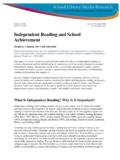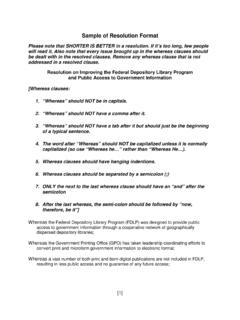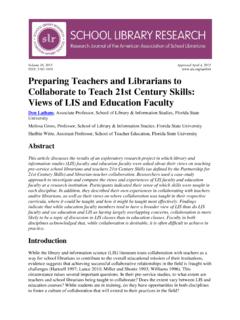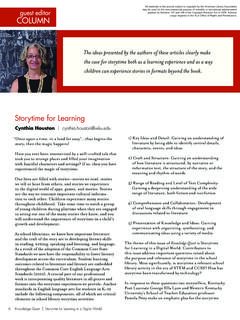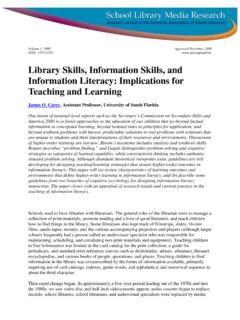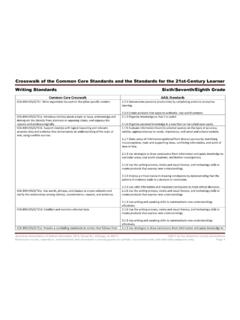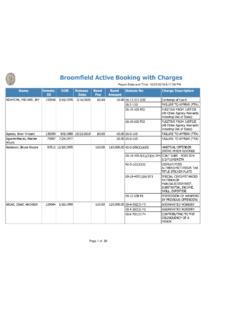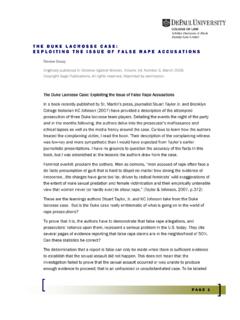Transcription of The Big Six Information Skills As a Metacognitive Scaffold ...
1 Volume 6, 2003 Approved June 2003. ISSN: 1523-4320 The Big Six Information Skills As a Metacognitive Scaffold : A Case Study Sara Wolf is an Assistant Professor of Educational Media at Auburn University, Auburn, Alabama; Thomas Brush is Associate Professor of Instructional Systems Design at Indiana University, Bloomington, Indiana; and John Saye is Associate Professor of Secondary Social Studies at Auburn University. Several Information problem-solving models exist for teaching and reinforcing the research, problem-solving, and writing processes. The Big Six Information Skills model (Big6) is one that is primarily aimed at kindergarten through twelfth-grade students.
2 This model is intended to foster the acquisition of research, problem-solving, and Metacognitive Skills through the cooperation of both school library media specialists and classroom teachers. While a strong anecdotal record exists supporting the use of Big6, empirical research support is less evident in library and education literature. This study examines the effect of Big6 on a class of eighth- grade students asked to research and write about events surrounding the African-American Civil Rights movement. This study describes the context of the task students were asked to complete, student's experiences and reactions, and some conclusions that might be drawn from their experiences.
3 It is a study based on a very small and homogenous set of students, but it tends to show the value of concise models that illustrate the full problem-solving process in order for young researchers to perhaps more fully grasp the extent of the task facing them. Such models, maps, and organizers should continue to be tested among many groups of learners to determine the full range of their value for giving the student greater confidence and understanding of the complexities involved in Information problem-solving. In an effort to create authentic experiences for students in schools, teachers, and school library media specialists infuse Information -literacy Skills into the curriculum.
4 Activities utilizing Information -literacy Skills are varied, from creating pamphlets on drugs in health class, to researching and recommending vacation trips in social studies class, to writing newspaper articles in journalism, English, or history classes. These authentic tasks often require an increased amount of Metacognitive attention on the part of the students, as they are generally not addressed in the kindergarten through twelfth-grade curricula. Through the use of a specific Information Skills model like Big6 these Skills can be developed in students of all ages (Eisenberg and Berkowitz 1990).
5 A review of the current literature reveals a strong anecdotal record supporting the use of the Big Six Information Skills model (Big6) in kindergarten through twelfth-grade curricula. The model is recommended for use as a programmatic change agent (Eisenberg and Berkowitz 1988), the basis for interdisciplinary evaluation of student work (Grover et ), a method for parents to use while assisting students with homework (Berkowitz 1998; Eisenberg and Berkowitz 1995), and the foundation of several specific projects developed by teachers ( Callison 1998; Jansen Volume 6 | ISSN: 1523-4320.)
6 1997; Jansen and Culpepper 1996; Johnson 1992; Roblyer 1998; and Spitzer 2000). However, empirical studies dealing with Big6 in a kindergarten through twelfth-grade setting are not similarly represented in the literature. Therefore, the authors sought to discover what effects Big6 might have on the Metacognitive Skills of eighth-grade students in order to begin building a body of research to support the continued implementation of this model throughout the kindergarten through twelfth-grade curricula. Information Problem Solving Information problem solving is a concept that combines the Skills needed to access and use Information , and those needed to apply and solve an Information problem (American Association of School Librarians 1998; Eisenberg and Berkowitz 1990).
7 In other words, whenever a student encounters a problem that requires Information in order to be solved, she is encountering an Information -based problem, also termed an Information problem (Eisenberg and Berkowitz 1990). Several researchers have examined behaviors and Skills associated with Information use (Kuhlthau 1993; Marchionini 1989; Oliver and Perzylo 1994; Perzylo and Oliver 1992; Small and Ferreira 1994; Stripling and Pitts 1988; Yang 1997). From this rich empirical and rational- empirical (Burisch 1984) body of knowledge, three prominent models of the research process have been developed.
8 These include the search process model (Kuhlthau 1993), the research process model (Stripling and Pitts 1988), and Big6 (Eisenberg and Berkowitz 1990). In an effort to better understand the research process or the Information problem-solving process, Kuhlthau (1993) examined the thoughts, feelings, and actions associated with various activities within this complex process. Her search process model details the changes that occur for searchers as they move from a generally unfocused to a focused state of mind while progressing from seeking relevant to pertinent Information .
9 This shift also describes feelings that ebb and flow between more negative emotions such as uncertainty, confusion, frustration, and doubt, to more positive emotions such as optimism, clarity, confidence and relief. While Kuhlthau examined searchers as they sought Information in a variety of situations, other authors focused on research paper writing in order to better understand the Information search process. For example, Stripling and Pitts describe their model as a thinking frame . (Stripling and Pitts 1988, 19) for research. This ten-step process emphasizes a thinking framework that can be adapted for any age level and any curricular subject.
10 The authors maintain that, unless they are instructed to do so, most students do not automatically think about research in an explicit manner. Therefore, by prescribing the method in which to write research papers, the authors hope to improve student thought about the research process. The ten steps of the search process model (Stripling and Pitts 1988) are organized around the major activities performed in writing a coherent research paper: topic selection, planning the Information search, locating and accessing materials, and creating a final product. Throughout the model, students have several reflection points that allow them to make judgments about their progress.
